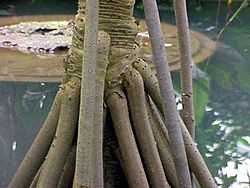Pandanaceae facts for kids
Quick facts for kids Pandanaceae |
|
|---|---|
 |
|
| typical screwpine habit | |
| Scientific classification | |
| Kingdom: | |
| Class: | |
| Order: | |
| Family: |
Pandanaceae
|
| Genera | |
|
See text |
|
The Pandanaceae is a family of flowering plants. These plants are found in warm, tropical, and subtropical parts of the Old World. This means they grow from West Africa all the way across to the Pacific Ocean.
This plant family includes five main groups, called genera, and about 900 different kinds of plants, known as species. These plants can be trees, shrubs, or even climbers that use their roots to hold on. Most members of the Pandanaceae family like to live near the coast or in wet, marshy areas.
Contents
What are Pandanaceae Plants?
Pandanaceae is a special group of plants that are often called "screw pines" or "pandans." Even though they are called screw pines, they are not actually pine trees. They get their name because their leaves often grow in a spiral, like a screw. These plants are very important in the places where they grow.
Where Do Pandanaceae Grow?
These plants love warm weather. You can find them in many tropical and subtropical areas around the world. They are common in places like Southeast Asia, Australia, and many islands in the Pacific Ocean. They often grow in wet places. This includes swamps, riverbanks, and along the seacoast. Some can even grow right on sandy beaches.
Types of Pandanaceae Plants
The Pandanaceae family has different kinds of plants. Some are tall trees, while others are smaller shrubs. There are also plants that climb using their roots. These climbers can grow up other trees or rocks. Each type has adapted to its specific environment.
The Pandanus Genus
The most well-known group in this family is the Pandanus genus. It has over 600 species. Many Pandanus plants have long, sword-shaped leaves. These leaves often have spiny edges. Some Pandanus trees have special roots that grow above the ground. These are called "prop roots." They help to support the plant, especially in sandy or wet soil.
Other Genera
Besides Pandanus, there are four other genera in the Pandanaceae family. These include Freycinetia, Sararanga, Benstonea, and Martellidendron. Each of these groups has its own unique features. For example, Freycinetia plants are often climbers. They have colorful parts that attract birds and bats for pollination.
Uses of Pandanaceae Plants
Pandanaceae plants are very useful to people in many ways. They provide food, materials for building, and are used in traditional crafts.
Food and Flavor
In many parts of Asia, the leaves of some Pandanus species are used in cooking. They give a sweet, unique smell and taste to dishes. This is similar to how vanilla is used in Western cooking. The leaves are often added to rice, desserts, and drinks. The fruits of some Pandanus plants are also eaten. They can be sweet and juicy.
Building and Crafts
The strong, fibrous leaves of Pandanaceae plants are used for many things. People weave them into mats, baskets, and hats. The leaves are also used to make roofs for houses. The wood from the trunks of some trees can be used for building small structures.
Traditional Medicine
Some parts of Pandanaceae plants have been used in traditional medicine for a long time. People believe they can help with different health problems. However, it's important to remember that these are traditional uses and not always scientifically proven.
Reproduction and Life Cycle
Pandanaceae plants reproduce using seeds. Many of them are "dioecious." This means that male flowers and female flowers grow on separate plants. For seeds to form, pollen from a male plant must reach a female plant. This is often done by wind or animals. After pollination, the female flowers develop into fruits that contain the seeds.
How Seeds Spread
The seeds of Pandanaceae plants are often spread by water or animals. For example, the fruits of some coastal species can float in the ocean. This allows their seeds to travel to new islands and beaches. Birds and other animals also eat the fruits. They then help to spread the seeds when they move to different places.
Interesting Facts
- Some Pandanus species can grow very tall, reaching up to 20 meters (about 65 feet).
- The prop roots of some Pandanus trees can look like stilts. They help the tree stand firm in loose soil.
- The fruits of some Pandanus plants look like large pineapples, but they are not related to pineapples.
See also
 In Spanish: Pandanáceas para niños
In Spanish: Pandanáceas para niños

